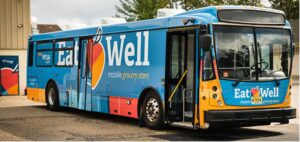3 Tips to Integrate Foodservice and Population Health
Healthcare is about taking care of people. Over the past decade, healthcare leaders have seen their role expand outside of the four walls of the hospital. This has led to a well-documented shift toward population health. Most hospitals have a clear understanding of the health needs of the communities they serve, particularly not-for-profit hospitals which are required to regularly update their Community Health Needs Assessment (CHNA).
In many cases, the CHNA serves as the basis for population health strategies, identifying underserved communities, and opportunities to make an impact. When looking at CHNAs nationally, a common theme emerges—food insecurity and access to healthy food. These results underscore the role of food in caring for patients and creating healthy communities.
Food and Nutrition Services departments can play an important role in meeting the needs of a community both in and out of the hospital walls. As a result, hospitals have seen the impact food has on the community and further integrated it into their wellness and population health initiatives.
The path to population health success is treacherous. Having the right partner can help hospitals avoid the potholes in the population health journey and find the best route. Working with hospitals across the country, Morrison Healthcare has seen it all and helped to implement programs that drive compassion and innovation. Using programmatic successes as the framework, we have put together 3 Tips to Integrate Food Service and Population Health to help you make a difference in the lives of your community.
1. Tell a Story
A perfectly conceived program will die on the vine if the intended community doesn’t know about it or isn’t bought into the concept. It’s important to tell the story of the program in the context of your intended audience. This comes down to education. Make sure your audience:
- Knows the history of health disparities in their community
- Recognizes how the program can benefit their personal health
- Understands what elements of the program they have access to
- Knows the logistics of the program and how to take advantage of the services
It seems simple, but too often, communication with stakeholders is limited. A great success story comes from Virtua Health in southern New Jersey. The health system created a mobile grocery delivery program called Eat Well Mobile Grocery Store. With a converted public transportation bus, dietitians deliver healthy food options (sold at cost) to areas that have been identified as food deserts.
Well-conceived and implemented, the program’s success is rooted in community outreach. Virtua Health started with surveys and conversations with the affected populations in Burlington and Camden Counties. Not only did they educate their audience, but they also listened and gained key insights that helped to make the program successful.
 One key learning was predictability. The Eat Well Mobile Grocery truck appears in the same locations each week, allowing residents to make healthy food part of their routine.
One key learning was predictability. The Eat Well Mobile Grocery truck appears in the same locations each week, allowing residents to make healthy food part of their routine.
“People can count on us,” said Frank Baccare, director of Food and Nutrition Services at Virtua Voorhees. “It is important for the long-term success of the program that our community knows that Eat Well Mobile Grocery will be at a certain location on a certain day. If they can count on us to be in a particular location each week, there is a higher likelihood they will embrace healthy eating habits.”
By telling your story in the community, you can create buy-in for population health initiatives and find success in sustainable programs.
2. Create Customized Solutions
This tip is not unique to population health. We see it in many areas of healthcare and life. One-size does not fit all. No two communities are the same. With different needs, they require different solutions. It’s important to solve their situation by creating customized solutions.
UVA Health saw a specific need in its community and created a program to address it. Identifying food insecurity as one of the biggest threats to the health of its patients, the health system created a program that brings regular deliveries of fresh produce to pediatric patients and their families. The need was even more obvious during the COVID-19 pandemic and the program was launched in November 2020.
By focusing on the needs of its pediatric population, UVA Health established a program that makes sense for its community. It’s this level of focus and customization that makes population health initiatives successful and sustainable.
3. Don’t Do it Alone
You don’t have to do it alone. Innovation does not happen in a bubble and your population health program development shouldn’t either. There are resources that can help hospitals see the bigger picture and utilize data to define the opportunity. Finding partners to help on your population health journey is critical to long-term success.
Morrison Healthcare has a history of working with its clients to develop population health programs that bring value to the hospital and the community it serves. It helps to have access to best practices and examples from across the U.S. This knowledge is invaluable in creating customized programs that integrate food and nutrition services into population health.
In South Carolina, Morrison Healthcare partnered with Spartanburg Regional Health System to address food insecurity. As they looked for opportunities, they found alignment with the local soup kitchen. Through collaboration, Spartanburg Regional helped the soup kitchen quadruple the number of meals they provided in 2020.
That is real, measurable impact on the community through creativity and partnership.
There are so many factors that go into creating a successful population health program. Hospitals need to identify the unique needs of their community and develop a plan to make a difference. It’s a big project but it’s not one you must do alone.
